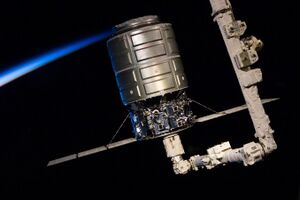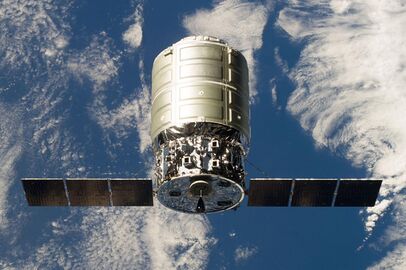Engineering:Cygnus Orb-D1
 Canadarm2 grapples the S.S. G. David Low | |
| Mission type |
|
|---|---|
| Operator | Orbital |
| COSPAR ID | 2013-051A |
| SATCAT no. | 39258 |
| Mission duration | 35 days |
| Spacecraft properties | |
| Spacecraft | S.S. G. David Low |
| Bus | Standard Cygnus[1] |
| Manufacturer |
|
| Launch mass | 4,127 kg (9,098 lb)[2] |
| Payload mass | 700 kg (1,500 lb)[3] |
| Start of mission | |
| Launch date | 18 September 2013, 14:58:02 UTC[4] |
| Rocket | Antares 110[1] |
| Launch site | Wallops Pad 0A |
| Contractor | Orbital |
| End of mission | |
| Disposal | Deorbited |
| Decay date | 23 October 2013, 18:16 UTC |
| Orbital parameters | |
| Reference system | Geocentric orbit[5] |
| Regime | Low Earth orbit |
| Inclination | 51.65° |
| Berthing at the International Space Station | |
| Berthing port | Harmony nadir |
| RMS capture | 29 September 2013, 11:00 UTC |
| Berthing date | 29 September 2013, 12:44 UTC |
| Unberthing date | 22 October 2013, 10:04 UTC |
| RMS release | 22 October 2013, 11:31 UTC |
| Time berthed | 22 days, 21 hours, 20 minutes |
 Orbital mission patch | |
Orbital-D1,[6] also known as Orb-D1,[7][8] and Cygnus 1,[9] was the first flight of the Cygnus cargo spacecraft developed by Orbital Sciences Corporation. It was named after the late NASA astronaut and Orbital Sciences executive G. David Low. The flight was carried out by Orbital Sciences under contract to NASA as Cygnus' demonstration mission in the Commercial Orbital Transportation Services (COTS) program. The mission launched on 18 September 2013 at 14:58:02 UTC. Cygnus was the seventh type of spacecraft to visit the International Space Station (ISS), after the crewed Soyuz and Space Shuttle, and uncrewed Progress, ATV, HTV and Dragon 1.
Spacecraft
The Cygnus Orb-D1 mission was the first flight of the Cygnus spacecraft and used the standard configuration with a Pressurized Cargo Module (PCM),[2] built by Thales Alenia Space, in Italy.[10]
Orbital named this mission's Cygnus spacecraft the G. David Low after the former NASA astronaut and Orbital employee who died of cancer on 15 March 2008.[11][12] During a media briefing for the Cygnus Orb-1 mission, Orbital Sciences executive vice president Frank Culbertson stated, "We were very proud to name that [Cygnus] the G. David Low".[13]
Launch and early operations
Cygnus Orb-D1 was launched by an Antares 110 launch vehicle flying from Pad 0A at the Mid-Atlantic Regional Spaceport (MARS).[1] The launch took place at 14:58:02 UTC on 18 September 2013, and successfully inserted the Cygnus into low Earth orbit. The launch marked the second flight of the Antares launch vehicle and the final flight of the interim Antares 110 configuration.[4][14]
ISS rendezvous
Rendezvous with the ISS was originally scheduled for the fourth day of the mission. However, the rendezvous was postponed due to a computer data link problem.[15] The exact error related to small discrepancies between the way the ISS and Cygnus each use GPS for timekeeping purposes.[16] A further delay was necessary to allow for the arrival of Soyuz TMA-10M with three new ISS crew members.[17]
A week late, the spacecraft conducted a series of navigation, control and safety tests as it approached the station. Following the successful completion of ten test objectives, the spacecraft was cleared to make its final approach, holding 12 m (39 ft) below the ISS. Then, Italian astronaut Luca Parmitano grappled it at 11:00 UTC, on 29 September 2013, using the Canadarm2 Mobile Servicing System (MSS) [8] as the two spacecraft sailed high above the Indian Ocean.[18] Cygnus was berthed to the nadir port of the station's Harmony node.[8]
Payload
Cygnus Orb-D1 carried 700 kg (1,500 lb) of cargo to the ISS, including food and spare parts.[3] After unloading, the spacecraft was loaded with 1,290 kg (2,840 lb) of cargo for disposal.[19]
End of mission
On 22 October 2013, the Canadarm2 was used to unberth the Cygnus spacecraft from the nadir port of the Harmony module at 10:04 UTC. The spacecraft was then maneuvered to a release position below the station, where it was released from the RMS at 11:31 UTC. It then performed a series of separation maneuvers away from the station. The spacecraft fired its main engine to de-orbit itself on 23 October 2013 at 17:41 UTC, with reentry and burning up in the atmosphere over the southern Pacific Ocean occurring at 18:16 UTC.[20][21]
Gallery
References
- ↑ 1.0 1.1 1.2 Bergin, Chris (22 February 2012). "Space industry giants Orbital upbeat ahead of Antares debut". NASASpaceFlight.com. http://www.nasaspaceflight.com/2012/02/orbital-upbeat-ahead-of-antares-debut/.
- ↑ 2.0 2.1 "Cygnus PCM". Gunter's Space Page. 11 December 2017. https://space.skyrocket.de/doc_sdat/cygnus-pcm.htm.
- ↑ 3.0 3.1 "Cygnus launch cargo". Spaceflight Now. 14 September 2013. http://spaceflightnow.com/antares/cots1/launchmanifest.html.
- ↑ 4.0 4.1 "Antares - Cygnus Orb-D1 Launch". Spaceflight 101. 18 September 2013. http://www.spaceflight101live.com/antares-launch-cygnus-orb-d-mission.html.
- ↑ "CYGNUS". N2YO.com. http://www.n2yo.com/satellite/?s=39258.
- ↑ "Orbital D-1". September 2013. https://www.issnationallab.org/launches/orbital-d1/.
- ↑ "ISS Daily Summary Report – 09/16/13". 16 September 2013. https://blogs.nasa.gov/stationreport/2013/09/16/. "Orbital-D1 (Orb-D1) Launch Preparations..."
- ↑ 8.0 8.1 8.2 "COTS Orb-D1 Mission Description". Orbital Sciences. 2013. http://www.orbital.com/NewsInfo/MissionUpdates/Orb-D1/files/5%20Mission%20Description.pdf.
- ↑ "Worldwide Launch Schedule". Spaceflight Now. 3 October 2012. http://spaceflightnow.com/tracking/index.html.
- ↑ "Cygnus Spacecraft: Cygnus Overview". Orbital Sciences. 14 September 2013. http://www.orbital.com/NewsInfo/MissionUpdates/Orb-D1/files/8%20Cygnus%20Overview.pdf.
- ↑ Harwood, William (29 September 2013). "Cygnus cargo ship captured by International Space Station". CBS News. http://www.cbsnews.com/news/cygnus-cargo-ship-captured-by-international-space-station/.
- ↑ Holley, Joe (20 March 2008). "G. David Low, 52: Cerebral Astronaut Flew on 3 Shuttles". The Washington Post. https://www.washingtonpost.com/wp-dyn/content/article/2008/03/19/AR2008031903469.html.
- ↑ Pearlman, Robert Z. (9 December 2013). "Orbital names next space station freighter for late pilot-astronaut". collectSPACE. http://www.collectspace.com/news/news-120913a.html.
- ↑ "Cygnus Orb-D1 Mission Status Center". Spaceflight Now. 18 September 2013. http://spaceflightnow.com/antares/cots1/status.html.
- ↑ Dunn, Marsha (22 September 2013). "Computer mishap delays space station supply ship Cygnus". The Washington Post. https://www.washingtonpost.com/national/health-science/computer-mishap-delays-space-station-supply-ship-cygnus/2013/09/22/69145610-23a0-11e3-b75d-5b7f66349852_story.html.
- ↑ Bergin, Chris; Harding, Pete (21 September 2013). "Cygnus delays ISS berthing following GPS discrepancy". NASASpaceFlight.com. http://www.nasaspaceflight.com/2013/09/cygnus-cots-graduation-iss-berthing/.
- ↑ Kramer, Miriam (23 September 2013). "Cygnus spacecraft's arrival at space station delayed by incoming crew". NBC News. http://www.nbcnews.com/science/cygnus-spacecrafts-arrival-space-station-delayed-incoming-crew-4B11233826.
- ↑ Hardwood, William (29 September 2013). "Cygnus cargo ship captured by International Space Station". CBS News. http://www.cbsnews.com/8301-205_162-57605162/cygnus-cargo-ship-captured-by-international-space-station.
- ↑ Clark, Stephen (22 October 2013). "Cygnus completes maiden visit to space station". Spaceflight Now. http://spaceflightnow.com/antares/cots1/131022departure/.
- ↑ "Canadarm2 Releases Cygnus After Successful Demonstration Mission". NASA. 22 October 2013. http://www.nasa.gov/content/canadarm2-releases-cygnus-after-successful-demonstration-mission-0/.
 This article incorporates text from this source, which is in the public domain.
This article incorporates text from this source, which is in the public domain.
- ↑ Beneski, Barron (23 October 2013). "Orbital Completes COTS Demonstration Mission to International Space Station" (Press release). Orbital Sciences. Retrieved 24 October 2013.
External links
- Orb-D1 mission page at Orbital.com
- Orb-D1 mission page at Spaceflight Now
- Video of the launch of Orb-D1
- Video of Cygnus being berthed to the ISS
- Video of the hatch to Cygnus being opened
- Video of the hatch to Cygnus being closed
- Video of Cygnus departing from the ISS
 |




